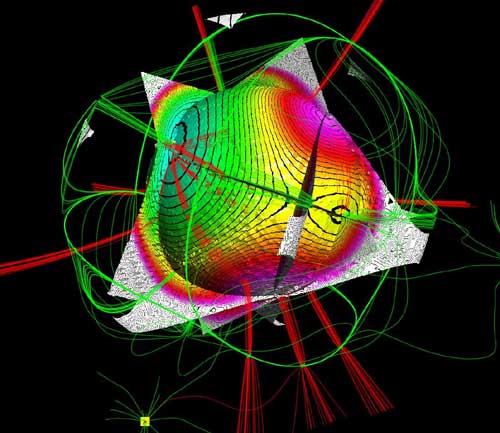 by Preston MacDougall May 06, 2008
Polaroid chemistry, that I basically understand, captured the moment when I was baptized by the holy water at St. Gregory's as an infant. Later on, neuronal chemistry, that nobody understands, remembers asking for a lift so that I could spritz myself with it at the church entrance.  Credit: P. J. MacDougall and C. E. Henze
You may already know that water expands when it freezes, which is already surprising since most things expand when they are heated. This is why icebergs float and potholes are born in the winter. Chemists explain this curious behavior by invoking the phenomenon known as the hydrogen bond. Hydrogen bonds were famously used to explain both the base-pairing and the double-helix structure of DNA in the '50s, but this chemical concept is almost as old as my grandmother. Such bonds are much weaker than the chemical bonds that hold the two hydrogen atoms to the oxygen atom between them in each molecule of water. But compared to interactions between other kinds of molecules (as opposed to within the molecules), the hydrogen bonds between water molecules are strong. And with moderate strength comes moderate directionality. A beautiful consequence of this is the six-fold symmetry of snowflakes. For instance, the weaker attractions between propane molecules are why it is a gas at room temperature and pressure. These attractions are also non-directional, so even when propane is liquefied under pressure, the molecules tumble over and around each other indiscriminately. As a result, the molecules mostly fill the space occupied by the liquid. Any gaps would be much smaller than an atom, and because they get smaller and fewer in number as the temperature drops, you don't have to worry about propane tanks exploding when the mercury shrinks. For better and worse, water is a different story. When water pipes burst, it's because as the water molecules cool they lose their tumbling energy and the preferred directionality of the hydrogen bonds forces clusters of adjacent water molecules into nano-scale icebergs that leave molecular-sized holes inside. Without these holes, mega-sized icebergs would sink and polar bears would have fewer travel options for spring vacation. When ice melts, the water molecules in the icebergs - both the big ones and the small ones - resume their tumbling and fill in the holes causing a noticeable reduction in volume. Interesting, but basically understood. Surprisingly, liquid water retains some of its holey-ness. I was reminded of this by a story told on NPR's Morning Edition on the Parsi New Year's Day, which is celebrated on March 21 - vernal equinox. The story recounted the mass migration of Zoroastrians from ancient Persia to the Western coast of the Indian subcontinent, forced by the spread of Islam over 1,000 years ago. As legend has it, the local Indian ruler presented a brimming jug of milk to indicate that while the land was bounteous, it was already full and so the newcomers could not settle permanently. To indicate that his people could enrich the land, without displacing any inhabitants, the Zoroastrian priest cleverly added sugar to the milk, which dissolved without spilling a drop. As lovely as this story is, I just had to test it. Milk is mostly water, and I was skeptical that water is that holey. Sure enough, adding sugar to room temperature water increases the volume of the resulting sugar water. (I didn't actually test milk, not because I didn't want to be sacrilegious, but I was out of milk.) Sugar molecules are several times larger than water molecules, so I was pretty sure of what would happen. I certainly wasn't expecting any shrinkage, but that is precisely what happens when certain substances, such as sodium hydroxide, are dissolved in water. Sodium hydroxide is the main ingredient in Drano. People who make their own soap know it as lye, or caustic soda. The next time you have a clogged drain, add a tablespoon of sodium hydroxide pellets to a long-neck bottle almost filled with water. (If you are using Drano, first remove all the shavings of aluminum metal, using tweezers since lye is a strong skin irritant.) If you marked the initial water level, after several minutes the lye will have all dissolved and the water level will be slightly lower. Where did it go? How could the water shrink? If you don't find this mysterious, it's time to unclog your drain. Of course, if you try this
experiment, for heaven's sake don't drink the holey water.
On the Web:
E-mail your letters & opinions to editor@sitnews.us SitNews ©2008 Stories In The News Ketchikan, Alaska |